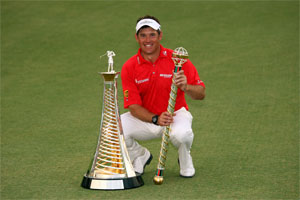Dubai World Championship Preview
The second Race to Dubai reaches its climax this week with the Dubai World Championship presented by DP World. Martin Kaymer leads the standings but Graeme McDowell is hot on his heels.


Lowdown: The second Race to Dubai reaches its climax this week with the Dubai World Championship presented by DP World. Martin Kaymer leads the standings but Graeme McDowell is hot on his heels. The top 60 players on the Race to Dubai standings at the end of the UBS Hong Kong Open have travelled to Jumeirah Golf Estates in Dubai to do battle over Greg Norman's Earth Course for the European Tour's richest prize. USPGA champion Martin Kaymer leads the rankings, the German is €290,000 ahead of Golf Monthly columnist Graeme McDowell. With over €900,000 going to the winner of the tournament, if either player takes the title this week they'll also claim the second Race to Dubai crown and over €1 million from the bonus pool. Last year's Dubai World Championship and Race to Dubai winner Lee Westwood lies in third place on the 2010 standings but, even if he were to defend his Dubai World Championship title, he wouldn't catch Kaymer. The leading 15 players on the rankings will share the $7,500,000 bonus pool so there will be a significant incentive for those players within striking distance of the top-15. After his victory last week in Hong Kong, Ian Poulter has climbed to fifth on the Race to Dubai standings and he'll be looking to continue his impressive run of form.
Venue: Earth Course, Jumeirah Golf Estates, Dubai Date: Nov 25-28 Course stats: par 72, 7,675 yards Purse: €5,530,000 Winner: €910,000 Defending Champion: Lee Westwood (-23)
TV Coverage: Thursday 25 - Live on Sky Sports 3 from 8am Friday 26 - Live on Sky Sports 3 from 8am Saturday 27 - Live on Sky Sports 1 from 8am Sunday 28 - Live on Sky Sports 3 from 8am
Player Watch: All eyes will be on the contest between Martin Kaymer and Graeme McDowell as they battle to become the second Race to Dubai champion. But, who else is a likely winner this week?
Rory McIlroy - The young Northern Irishman came into this event last year as a potential winner of the inaugural Race to Dubai. He finished a fine third in the tournament but could do nothing about the excellence of Lee Westwood. After announcing his planned return to the European Tour in 2011, he'll be looking to make his presence felt this week. He's not been at his best through the second half of 2010 but good performances at the WGC HSBC Champions and the Hong Kong Open suggest he may be re-finding his form.
Ian Poulter - He played superbly last week to win in Hong Kong and his confidence is sky high. He's confirmed he will play in the US next season and with the mandatory number of events on the European Tour being raised to 13 next year, he may not have the chance to win the tournament in 2011.
Lee Westwood - The new World Number 1 has looked a different man since taking over from Tiger Woods at the top of the golfing pile. He would have won on his last outing, at the WGC-HSBC Champions, had it not been for an outstanding performance from Francesco Molinari. He won this tournament last year with something to spare and it would hardly be surprising if he repeated the feat this time out.
Subscribe to the Golf Monthly newsletter to stay up to date with all the latest tour news, equipment news, reviews, head-to-heads and buyer’s guides from our team of experienced experts.
Key hole: 18th. A long par 5 with water to the right from the tee and bunkers to the left. The second shot requires a decision - the fairway is split in two and you can either play to a generous landing area on the left leaving a longer and more difficult third, or go to the narrow lay-up area on the right leaving a more straightforward pitch. It's a great tactical challenge.
Skills required: Finishing. The last four holes of the Earth Course are particularly testing. The 15th is a short yet strategically demanding par 4, then comes a tough and long par 4 where water lurks right, the 17th is an exciting par 3 where the players fire to an island green, the round culminates with the challenging par 5 as described above. Negotiating these closing holes will be the key to success around the Earth Course.

Fergus is Golf Monthly's resident expert on the history of the game and has written extensively on that subject. He has also worked with Golf Monthly to produce a podcast series. Called 18 Majors: The Golf History Show it offers new and in-depth perspectives on some of the most important moments in golf's long history. You can find all the details about it here.
He is a golf obsessive and 1-handicapper. Growing up in the North East of Scotland, golf runs through his veins and his passion for the sport was bolstered during his time at St Andrews university studying history. He went on to earn a post graduate diploma from the London School of Journalism. Fergus has worked for Golf Monthly since 2004 and has written two books on the game; "Great Golf Debates" together with Jezz Ellwood of Golf Monthly and the history section of "The Ultimate Golf Book" together with Neil Tappin , also of Golf Monthly.
Fergus once shanked a ball from just over Granny Clark's Wynd on the 18th of the Old Course that struck the St Andrews Golf Club and rebounded into the Valley of Sin, from where he saved par. Who says there's no golfing god?